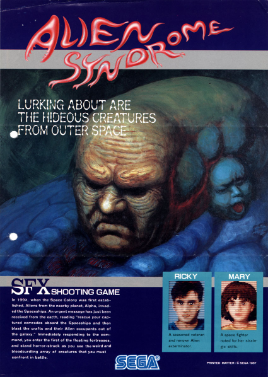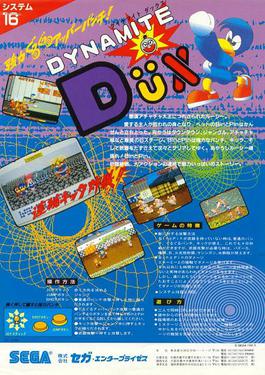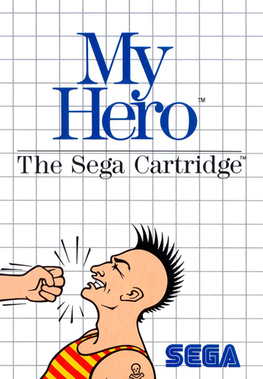Shoot 'em ups are a sub-genre of action games. There is no consensus as to which design elements compose a shoot 'em up; some restrict the definition to games featuring spacecraft and certain types of character movement, while others allow a broader definition including characters on foot and a variety of perspectives.

Alien Syndrome is a run and gun video game developed by Sega and released in arcades in 1987, and later ported to the Master System in 1988. The game utilizes a side-scrolling feature that allows the player to take control of either a male (Ricky) or female (Mary) soldier whilst hunting aliens and saving hostages before they run out of time.
An action game is a video game genre that emphasizes physical challenges, including hand–eye coordination and reaction time. The genre includes a large variety of sub-genres, such as fighting games, beat 'em ups, shooter games, rhythm games and platform games. Multiplayer online battle arena and some real-time strategy games are also considered action games.
Shooter video games or shooters are a subgenre of action video games where the focus is almost entirely on the defeat of the character's enemies using the weapons given to the player. Usually these weapons are firearms or some other long-range weapons, and can be used in combination with other tools such as grenades for indirect offense, armor for additional defense, or accessories such as telescopic sights to modify the behavior of the weapons. A common resource found in many shooter games is ammunition, armor or health, or upgrades which augment the player character's weapons.

Kung-Fu Master, known as Spartan X in Japan, is a side-scrolling beat 'em up developed by Irem as an arcade video game in 1984, and distributed by Data East in North America. Designed by Takashi Nishiyama, the game was based on Hong Kong martial arts films. It is a loose adaptation of the Jackie Chan, Sammo Hung, and Yuen Biao film Wheels on Meals (1984), called Spartan X in Japan, with the protagonist Thomas named after Jackie Chan's character in the film. The game is also heavily inspired by the Bruce Lee film Game of Death (1972), which was the basis for the game's concept. Nishiyama, who had previously designed the side-scrolling shooter Moon Patrol (1982), combined fighting elements with a shoot 'em up gameplay rhythm. Irem and Data East exported the game to the West without the Spartan X license.

Nekketsu Kōha Kunio-kun, released as Renegade in the West, is a beat 'em up video game developed by Technōs Japan and distributed by Taito for the arcades in 1986. In the original Japanese version Nekketsu Kōha Kunio-kun, the game revolves around a high-school delinquent named Kunio-kun who must stand up against a series of rival gangs frequently targeting his classmate Hiroshi. In the Western version Renegade, the player controls a street brawler who must face four different gangs in order to rescue his girlfriend being held captive by a mob boss.

Teenage Mutant Ninja Turtles: The Hyperstone Heist, released in Europe as Teenage Mutant Hero Turtles: The Hyperstone Heist and in Japan as Teenage Mutant Ninja Turtles: Return of the Shredder, is a 1992 side-scrolling beat 'em up game developed and published by Konami for the Sega Genesis, based on the Teenage Mutant Ninja Turtles comic book characters. It was Konami's debut title for the Genesis. The game was re-released as part of Teenage Mutant Ninja Turtles: The Cowabunga Collection in 2022.

Streets of Rage 2, known as Bare Knuckle II in Japan, is a 1992 side-scrolling beat 'em up video game published by Sega for the Genesis/Mega Drive. A sequel to Streets of Rage (1991), the characters Axel Stone and Blaze Fielding return while the game also introduces two new characters: Max Thunder, and Eddie "Skate" Hunter, the younger brother of Adam Hunter from the first game.

Dungeons & Dragons: Tower of Doom, published in 1994, is the first of two arcade games created by Capcom based on the Dungeons & Dragons tabletop role-playing game and set in the Mystara campaign setting. It is a side scrolling beat 'em up with some role-playing video game elements for one to four players. The game was also released on the Sega Saturn, packaged with its sequel, Dungeons & Dragons: Shadow over Mystara, under the title Dungeons & Dragons Collection, although the Saturn version limited the gameplay to only two players. In 2013, both games were re-released for modern platforms as Dungeons & Dragons: Chronicles of Mystara.

Guardian Heroes is a 2D side-scrolling beat 'em up video game in the vein of Final Fight or Golden Axe, but with RPG elements. The development team called it a "fighting RPG". Guardian Heroes was developed by Treasure and released in 1996 for the Sega Saturn video game console. A sequel was released in 2004 for the Game Boy Advance entitled Advance Guardian Heroes.

Double Dragon is a 1987 beat 'em up video game developed by Technōs Japan and distributed by Taito for arcades across Asia, North America and Europe. It is the first title in the Double Dragon franchise. The game's development was led by Yoshihisa Kishimoto, and it is a spiritual and technological successor to Technos' earlier beat 'em up, Nekketsu Kōha Kunio-kun (1986), released outside of Japan by Taito as Renegade; Kishimoto originally envisioned it as a direct sequel and part of the Kunio-kun series, before making it a new game with a different cast and setting.
A beat 'em up is a video game genre featuring hand-to-hand combat against a large number of opponents. Traditional beat 'em ups take place in scrolling, two-dimensional (2D) levels, while a number of modern games feature more open three-dimensional (3D) environments with yet larger numbers of enemies. The gameplay tends to follow arcade genre conventions, such as being simple to learn but difficult to master, and the combat system tends to be more highly developed than other side-scrolling action games. Two-player cooperative gameplay and multiple player characters are also hallmarks of the genre. Most of these games take place in urban settings and feature crime-fighting and revenge-based plots, though some games may employ historical, science fiction or fantasy themes.

Time Gal is an interactive movie video game developed and published by Taito and Toei Company, and originally released as a laserdisc game in Japan for the arcades in 1985. It is an action game which uses full motion video (FMV) to display the on-screen action. The player must correctly choose the on-screen character's actions to progress the story. The pre-recorded animation for the game was produced by Toei Company.
A side-scrolling video game is a game viewed from a side-view camera angle where the screen follows the player as they move left or right. The jump from single-screen or flip-screen graphics to scrolling graphics during the golden age of arcade games was a pivotal leap in game design, comparable to the move to 3D graphics during the fifth generation.

Arabian Fight (アラビアンファイト) is a scrolling beat 'em up video game released in arcades by Sega in 1992. Running on the Sega System 32 arcade system, the game displays pseudo-3D sprite-scaling graphics and supports cooperative multiplayer for up to four players.

The Punisher is a 1993 beat 'em up arcade game developed and released by Capcom. It stars the Marvel Comics' antihero the Punisher and co-stars S.H.I.E.L.D. agent Nick Fury as the second player's character as they embark on a mission to kill the crime lord the Kingpin and bring down his organization. While following the same general formula as Capcom's previous beat 'em ups, the game has a range of usable weapons and a comics-style presentation.

Dynamite Düx is a beat 'em up developed by Sega AM2 and released by Sega as an arcade video game in 1988. Produced by Yu Suzuki and with music composed by Hiroshi Kawaguchi, the game uses the Sega System 16 arcade board, the same board used for Golden Axe and Altered Beast. It was ported to the Master System, Amiga, Amstrad CPC, Atari ST, Commodore 64, and ZX Spectrum platforms in the following year. A Mega Drive version was planned but never released.

Moon Cresta is a fixed shooter video game released by Nichibutsu for arcades in 1980. In North America, it was licensed to Sega/Gremlin and Centuri, the latter releasing it in arcades as Eagle. Incentive Software published ports of Moon Cresta for the Amstrad CPC, Commodore 64, Dragon 32 and ZX Spectrum home computers. In 2022, the original arcade version will be included as part of the Sega Astro City Mini V, a vertically-oriented variant of the Sega Astro City mini console.

My Hero, known as Seishun Scandal in Japan, is a side-scrolling beat 'em up game released by Sega for arcades in 1985 and for the Master System on January 1, 1986. It was designed by Kotaro Hayashida.

Sturmwind is a 2013 scrolling shooter video game developed by German studio Duranik and originally published by RedSpotGames as an independent commercial release for the Dreamcast. It was re-released in 2016 and 2017, without the original RedSpotGames branding. A remastered version titled Sturmwind EX was also released for Microsoft Windows, Nintendo Switch and Xbox One. Controlling a space fighter craft, the player must fight endless waves of enemy forces while avoiding collision with their projectiles and other obstacles. The gameplay consist of vertical-scrolling and horizonal-scrolling stages, with players collecting three different weapon types in the vein of Thunder Force and Axelay.















